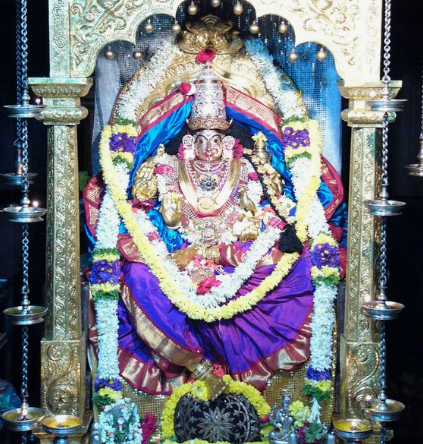
Who has not heard about the place Sringeri? The entire Bharata-varsha knows Sringeri as the prime seat of the Adi-Shankaracharya, the profounder of the Advaita Siddhanta.
Located in the western ghats, on the banks of the Tunga river in the Indian state of Karnataka, Sringeri is very popular for the Sringeri Shardamba Temple. It is beautifully surrounded by the lush green mountains called the Rishyashringa Parvata named after the Sage Rishyashringa from the Ramayana. The most unique feature about Sringeri is that it still preserves the Vedic heritage and is untouched by the so called modern development.
Sringeri became more popular with the Adi-Shankaracharya setting up the first and foremost of his mutts – Sringeri Sharada Peetham here. Adi Shankaracharya was looking for a holy place where he would found an institution to spread the Advaita Siddhanta. When he came to Sringeri, he witnessed an unusual event here. A cobra spread it’s hood over a frog in labor pain, to give shadow from the scorching sun. Looking at this wonderful sight, he realized the sanctity of this place that it could infuse love even amongst the natural enemies and immediately decided that this would be the site for the Mutt. Following this, he spent twelve years of his life in Sringeri.
Sringeri’s connection to the Ramayana
The name Sringeri is connected to Sage Rishyashringa who was born of Sage Vibhandaka and a deer under unique circumstances. The child was born with a horn in the forehead. Sage Vibhandaka brought up Rishyashringa in complete isolation in the forest away from the worldly life of the cities and villages so that he might not fall into maya. He succeeded to the extent that Sage Rishyashringa wasn’t even aware of the presence of the opposite sex.
Once when the neighboring kingdom was suffering from severe drought, King Romapada’s ministers’ suggested that if Sage Rishyashringa was brought to the Kingdom, there would be rains. King Romapada sent many damsels to the forest to bring the Sage to the kingdom who approached the hermitage only when Sage Vibhandaka was away from the ashram. Sage Rishyashringa was wonderstruck when he saw the damsels as he had never seen a women in his life until then. He was astonished at the different sweets offered to him by the damsels as he had never tasted them. The damsels left the ashram immediately fearing that Sage Vibhandaka could come anytime along with an invitation to Sage Rishyashringa to visit their residence nearby. The Sage took them to be Sages of a different kind with beautiful hairs, different bodily features and delicious fruits. One day, Sage Rishyashringa decide to visit the residence of the damsels as he was fascinated by their appearance and hence couldn’t control the restlessness. He was persuaded by the damsels to come along with them to the kingdom of King Romapada to which he agreed.
King Romapada on learning that Sage Rishyashringa had set out to his kingdom came with his retinue at the frontiers of his kingdom to receive the Sage. As soon as the Sage arrived and entered the Kingdom, rains started pouring on the kingdom thus ending the drought that had been affecting the kingdom for a long time. In gratitude, King Romapada offered his daughter Shanta in marriage whom the Sage accepted as his wife and remained in the King’s palace for some time. Sage Rishyashringa also officiated in King Dasaratha’s Puthrakameshti Yagna which resulted in King Dasaratha being blessed with four sons beginning with Lord Rama. This gave the Sage an opportunity to associate his name with Lord Rama’s pastime eternally.
Sage Rishyashringa felt the need to go back to the forest after some time and spend the remainder of his life in penances. While leaving his body, a lightning bolt appeared from his body and entered the Shivalinga that he used to worship. The Shivalinga is still being worshiped at Kigga, a village ten kilometers from Shringeri. A horn is still attached to the Shivalinga to commemorate this pastime. And the Shivalinga which was worshiped by Sage Sage Vibhandaka who later merged with the same Shivalinga, is situated atop a hill in the center of Sringer and is known as Malahanikaresvara.
Sharadamba Temple
The Sharadamba temple is the central attraction of Sringeri. Originally, the temple was a yantra carved on a rock in the middle of the Tunga river with a sandalwood Deity of Sharada Devi consecrated on it. The Deity was covered by a thatched roof. Sri Adi- Shankaracharya himself got the whole work done. The present temple has a Deity made of gold which was done during the reign of Sri Vidyaranya. The Deity of Sharadamba is seated gracefully in padmasana with four hands holding amrita kalasha, vedas, a japa-mala and the chin-mudra signifying identity of jiva. She is the presiding Deity of the Sri Yantra. She is also known as Sharada Parameshwari and puja is done reciting the Lalita Sahasranama to her. Sri Vidyaranya also replaced the thatched roof with a tiled roof. Later, a grand temple was built whose Kumbhabhishekam was done in 1916. This event was attended by the then Maharaja of Mysore.
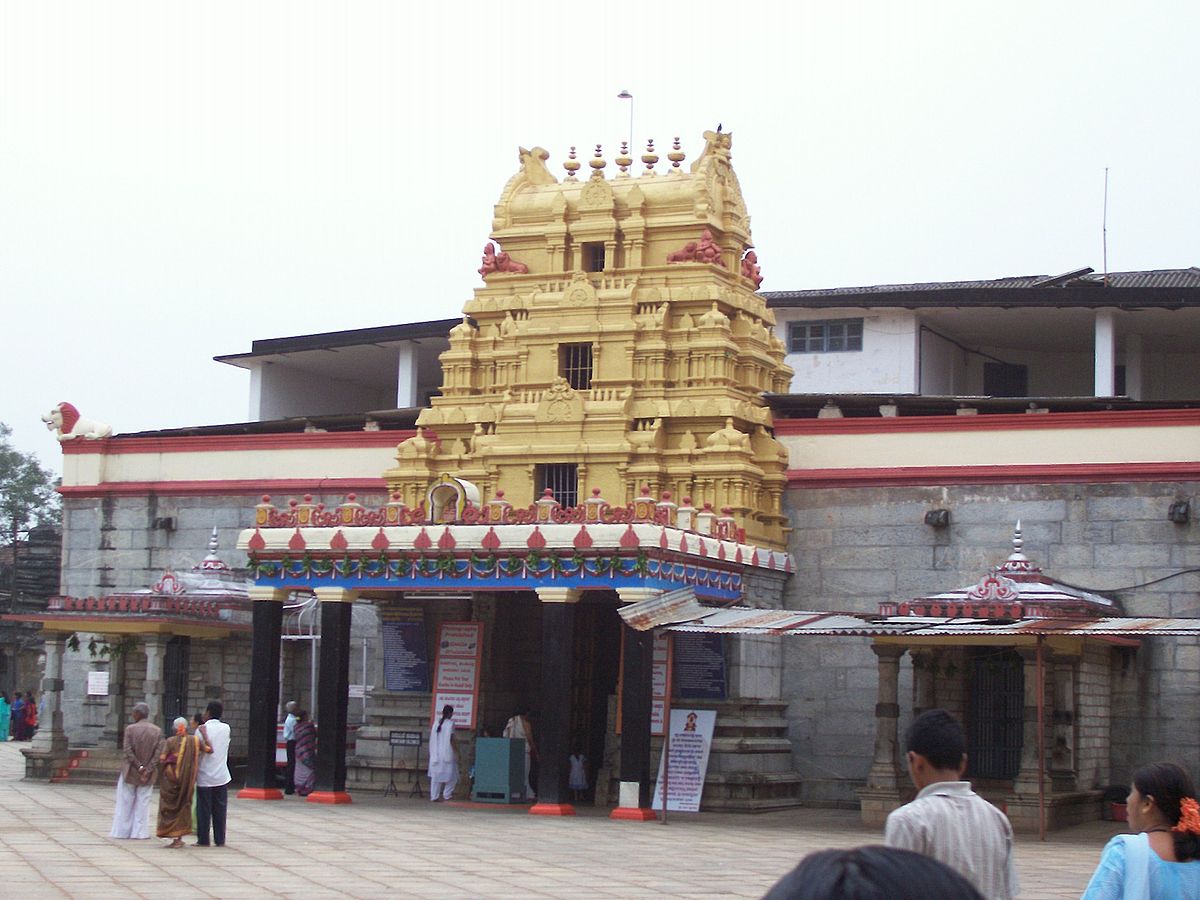
The temple is built in the Nattukottai Chetti style building. The Garba Griha and the small hall in front is surrounded by pradakshina prakara i.e. circumambulation path. The Deity could be seen from a distance even beyond the gateway. Within the temple is kept the Vyakhyana-dharmasimhasana which represents the sarvajnapitha. Every new Acharya who assumes the title of the Shankaracharya of the mutt is inducted into this throne. When Adi-Shankaracharya set up his mutt in Sringeri, his first built four guardian temples on the surrounding hillocks to protect the village from enemies, diseases, etc. On the eastern hillock, he built a Kala Bhairava Temple, Anjaneya Temple on the west, a Durga Temple on the south and a Kali Temple on the northern side.
Other temples and samadhis
There are many other temples surrounding the Sharadamba Temple some being Deities that are specially worshiped at Sringeri. These include the temple of Sri Vidyashankara – a fine architectural quintessence, the temples of Lord Rama, Janardhana, Hanuman, Garudadev, Lord Brahma, Bhuvaneswari Devi and many others besides a large number of Bana Lingas and Shaligramas. Of all these, importance is given to the Chandramouleswara Linga, Ratnagarbha Ganapati, Sri Chakra Yantra, Sphatika Meru Yantra, Shri Sharada Devi and Sri Shankaracharya.
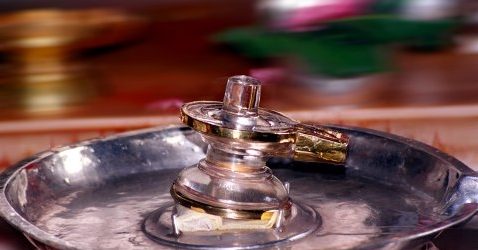
The Sphatika Linga of Lord Chandramouleswara is not to be seen anywhere else. It is said that this Sphatika Linga was given to Sri Adi-Shankaracharya by Lord Vishweshwara (Lord Shiva) Himself at Kashi i.e. Varanasi. It is always kept with the reigning Shankaracharya and worshiped. Apart from the temples, the samadhis of previous Shankaracharyas of the mutt are present all around. In most of the samadhis, Shivalingas have been installed and are being worshiped. Only the samadhis of Sri Sacchidananda Shivabhinava Narasimha Bharati and Sri Chandrashekhara Bharati are on the right bank of the river Tunga in Narasimhavanam free from the hustle and bustle of the town.
Sringeri Mutt
Sri Shankaracharya is the founder of the Sringeri Mutt. He played a major role in spreading the teachings of the Vedanta through the Mutt’s he established, of which Sringeri is the chief. Four Mutts were founded in the four cardinal directions of India in order to take care of the disciples in the nearby areas. The four Mutt’s are –
1. Kalika Mutt in Dwarka (West)
2. Badarikashrama or Jyotir Mutt in the Himalayas (North)
3. Govardhan Mutt in Puri (East)
4. Sharada Mutt in Sringeri (South)
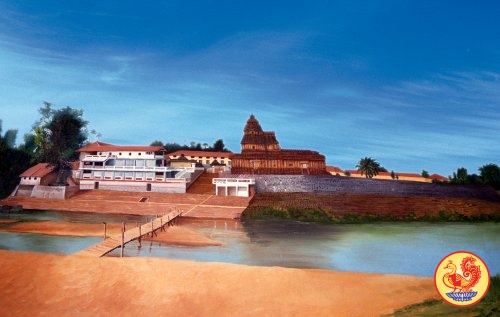
Each Mutt is headed by a Sannyasi with the title of Shankaracharya and associated with different Deities, Tirthas, Vedas, Acharyas, Sampradayas, Mahavakyas and titles. But, the Sringeri Mutt commands the highest respect amongst them all. The attributes associated with the Sringeri Mutt are
1. Deities: Malahanikara Linga; Varaha Shakti-Sharada
2. River: Tungabhadra
3. Acharya: Sri Sureshwara
4. Veda: Yajur
5. Sampradaya: Bhurivala
6. Mahavakya: Aham Brahmasmi
7. Titles: Saraswathi, Puri, Bharati, Aranya Tirtha, Giri, Asrama
Sri Shankaracharya had appointed his four disciples in charge of the four mutts i.e. Sri Padmapadacharya in the west, Sri Totakacharya in the north, Sri Hastamalakacharya in the east and Sri Sureshwaracharya in the south.
Life of Shankaracharya
Sri Shankara was born to Sri Shivaguru and Srimati Aryamba at Kaladi in Kerala. His father passed away when he was 3. He was initiated in the Gayatri mantra at the age of 5. He was very quick and intelligent in understanding various kinds of knowledge. At the age of eight, he took up Sannyasa and went in the search of a competent teacher. He eventually found Govinda Bhagavatpada on the banks of the Narmada. After staying with his Guru, he was advised to go and stay in Kashi and Badri where he composed his Bhasyas on the Prasthanaatraya. He went to meet Kumarila Bhatta, the expert in Karma Mimamsa who directed him to meet his foremost disciple Viswarupa, also known as Mandana Misra who later subscribed to Sri Shankaracharya’s views and took up Sannyasa becoming Sri Sureshwaracharya.
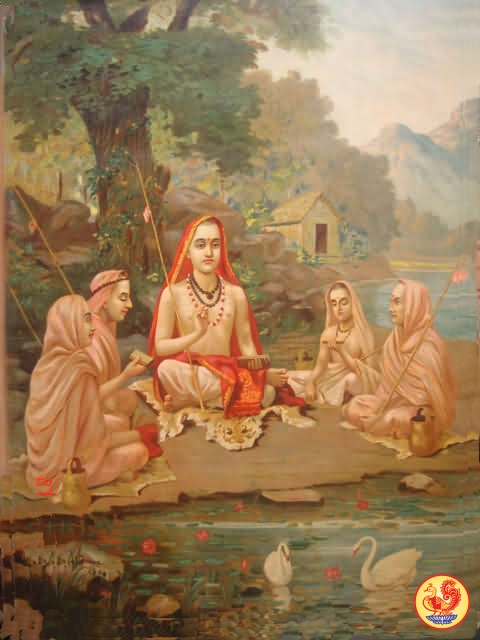
Adi-Shankara went on a religious tour of India condemning practices that were against the scriptures and re-establishing Vedic principles. After the creation of the four mutts, he ascended the Sarvajna Peetham in Kashmir. Before the age of 32, he had completed all this work.
Festivals of Sringeri
The important festivals celebrated in Sringeri are –
1.Shankara Jayanthi celebrated in the Vaisaka Sukla Panchami i.e. April-May for five days – especially important in Kaladi and Sringeri.
2.Navaratri which is the most important festival of Sharada Devi in Sringeri. Pujas to Sharada Devi and Sri Chakra are conducted elaborately by the presiding Shankaracharya of the Mutt. Sharadamba Devi is richly decorated with priceless jewels and rides on different mounts each day. Chandi Homa is performed on the final day. The Goddess is taken in a procession on the Vijayadashami day.
3.Maha Shivaratri where pujas are conducted for Lord Malahanikareswara during the day while pujas for Lord Chandramouleswara are performed during the night.
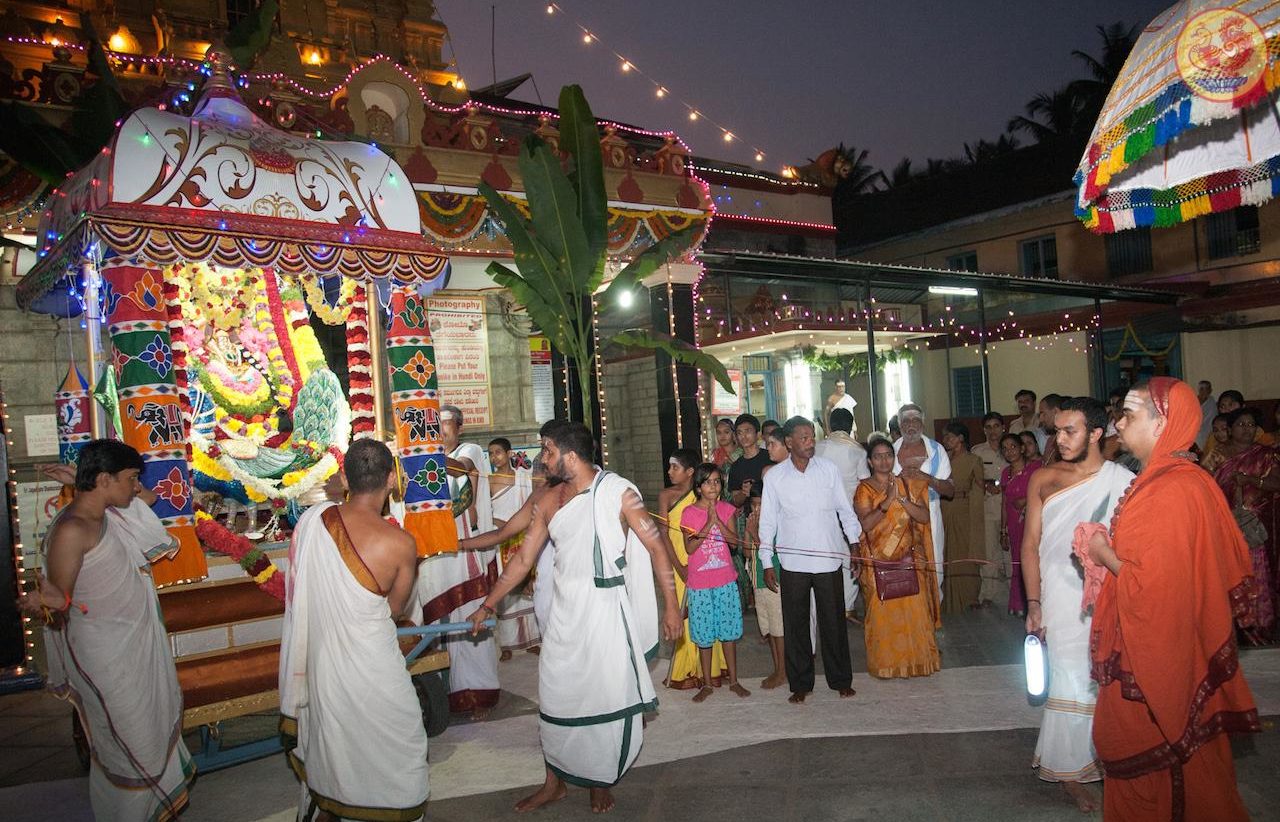
Apart from the above mentioned important festivals, Vyasa Puja, Varamahalakshmi Vratam, Kedareswara Vrata, Ananta Padmanabha Vrata, Sharadamba Abhishekam, Ardrotsava, Ratha Saptami, Vamana Jayanti, Krishnashtami and many more festivals are celebrated here.
How to reach
1. By Bus – There are buses from many cities to Sringeri.
2. By Train – You can catch a train to Udupi or Barkur in Karnataka and then board a bus or take a cab to Sringeri from there which is 55 kms and 54 kms respectively.
3. By Flight – You can catch a domestic flight to Bajpe Airport in Mangalore or the Mysore Airport from where Sringeri is 71 kms and 196 kms respectively by bus or cab.
6











6 Comments On Sringeri – the prime seat of Advaita Vedanta
Sahana L
Pretty good article. I just stumbled upon your blog and wanted to say that I have really enjoyed reading your blog posts.
Amit
I consider your articles as authentic, it would be more authentic if you add references about the history or pastime that u put on your article. As it becomes difficult to believe anyone in todays world without reference.
Hare Krishna
Namaste Amit, Thank you for your feedback. We have put up references wherever possible in our articles. In case where there aren’t any direct references, we shall try to mention the source such as the name of the book from where the content has been adapted. Regards
Vanee
Please let me know when is this trip being conducted
Sringeri is covered as a part of our Udupi Yatra which is happening from August 15 – 19, 2018.
All your. Blogs are so good feel as if we r there. I’ve shared in my groups too. Would be lovely if the packaged tours are more subsidised n affordable. Thanks Dr V Janaki Chennai